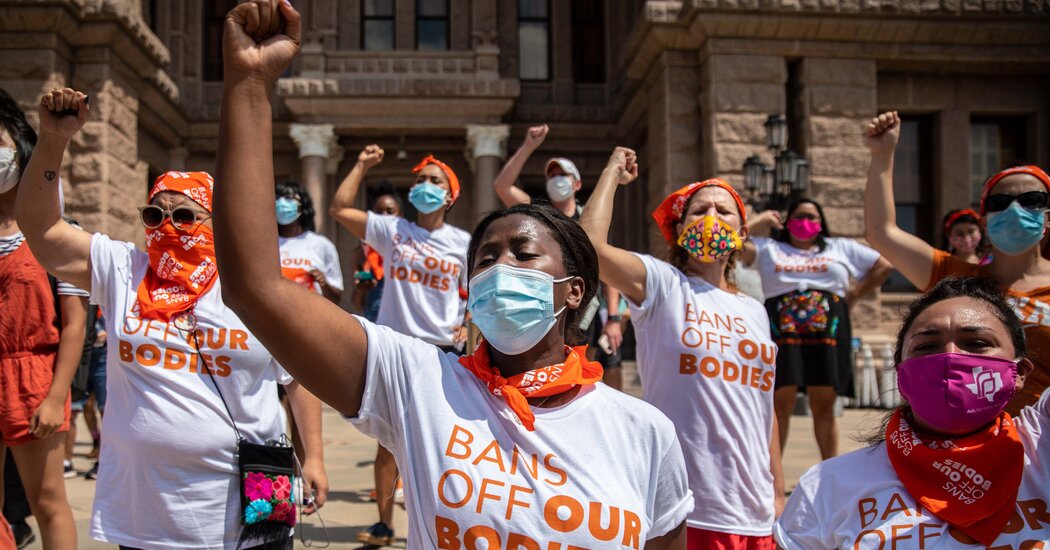
The Supreme Court refused just before midnight on Wednesday to block a Texas law prohibiting most abortions, less than a day after it took effect and became the most restrictive abortion measure in the nation.
The vote was 5 to 4, with Chief Justice John G. Roberts Jr. joining the court’s three liberal members in dissent.
The majority opinion was unsigned and consisted of a single long paragraph. It said the abortion providers who had challenged the law in an emergency application to the court had not made their case in the face of “complex and novel” procedural questions. The majority stressed that it was not ruling on the constitutionality of the Texas law and did not mean to limit “procedurally proper challenges” to it.
But the ruling was certain to fuel the hopes of abortion opponents and fears of abortion rights advocates as the court takes up a separate case in its new term this fall to decide whether Roe v. Wade, the landmark 1973 decision establishing a constitutional right to the procedure, should be overruled. It also left Texas abortion providers turning away patients as they scrambled to comply with the law, which prohibits abortions after roughly six weeks.
All four dissenting justices filed opinions.
“The court’s order is stunning,” Justice Sonia Sotomayor wrote in her dissent. “Presented with an application to enjoin a flagrantly unconstitutional law engineered to prohibit women from exercising their constitutional rights and evade judicial scrutiny, a majority of justices have opted to bury their heads in the sand.”
“The court has rewarded the state’s effort to delay federal review of a plainly unconstitutional statute, enacted in disregard of the court’s precedents, through procedural entanglements of the state’s own creation,” Justice Sotomayor wrote. “The court should not be so content to ignore its constitutional obligations to protect not only the rights of women, but also the sanctity of its precedents and of the rule of law.”
Chief Justice Roberts wrote that he would have blocked the law while appeals moved forward.
“The statutory scheme before the court is not only unusual, but unprecedented,” he wrote. “The legislature has imposed a prohibition on abortions after roughly six weeks, and then essentially delegated enforcement of that prohibition to the populace at large. The desired consequence appears to be to insulate the state from responsibility for implementing and enforcing the regulatory regime.”
The chief justice underscored the tentative nature of the majority’s ruling. “Although the court denies the applicants’ request for emergency relief today,” he wrote, “the court’s order is emphatic in making clear that it cannot be understood as sustaining the constitutionality of the law at issue.”
Justice Elena Kagan criticized the court’s practice of deciding important issues in rushed decisions without full briefing or oral argument — on what Supreme Court specialists call its “shadow docket.”
“Today’s ruling illustrates just how far the court’s ‘shadow-docket’ decisions may depart from the usual principles of appellate process,” she wrote. “That ruling, as everyone must agree, is of great consequence.”
“Yet the majority has acted without any guidance from the court of appeals — which is right now considering the same issues,” she wrote. “It has reviewed only the most cursory party submissions, and then only hastily. And it barely bothers to explain its conclusion — that a challenge to an obviously unconstitutional abortion regulation backed by a wholly unprecedented enforcement scheme is unlikely to prevail.”
“In all these ways,” Justice Kagan wrote, “the majority’s decision is emblematic of too much of this court’s shadow-docket decision making — which every day becomes more unreasoned, inconsistent and impossible to defend.”
The Texas law, known as Senate Bill 8, amounts to a nearly complete ban on abortion in Texas because 85 to 90 percent of procedures in the state happen after the sixth week of pregnancy, according to lawyers for several clinics. On Tuesday night, clinics were scrambling to see patients until the minute the law went into effect, with six-hour waits for procedures in some places. By Wednesday, the patient lists had shrunk, clinic workers said in interviews.
The law is the latest battle over abortion rights in the United States. In recent years, anti-abortion campaigners have found success through laws in state legislatures, and a broad swath of the South and the Midwest now has limited access to abortions.
In the emergency application urging the justices to intervene, abortion providers in the state said the new law “would immediately and catastrophically reduce abortion access in Texas,” and most likely force “many abortion clinics ultimately to close.”
Supreme Court precedents prohibit states from banning abortion before fetal viability, the point at which fetuses can sustain life outside the womb, or about 22 to 24 weeks into a pregnancy. The law in Texas says doctors cannot perform abortions if a heartbeat is detected, activity that starts at around six weeks, before many women are even aware they are pregnant.
Many states have passed such bans, but the law in Texas is different. It was drafted to make it difficult to challenge in court.
Usually, a lawsuit seeking to block a law because it is unconstitutional would name state officials as defendants. However, the Texas law, which makes no exceptions for pregnancies resulting from incest or rape, bars state officials from enforcing it and instead deputizes private individuals to sue anyone who performs the procedure or “aids and abets” it.
The patient may not be sued, but doctors, staff members at clinics, counselors, people who help pay for the procedure, and even an Uber driver taking a patient to an abortion clinic are all potential defendants. Plaintiffs, who do not need to live in Texas, have any connection to the abortion or show any injury from it, are entitled to $10,000 and their legal fees recovered if they win. Prevailing defendants are not entitled to legal fees.
That novel formulation has sent clinics scrambling.
Dr. Jessica Rubino, a doctor at Austin Women’s Health Center, a small, independent clinic in the state capital, said that at first, she wanted to defy what appeared to be an unconstitutional law. But she said she concluded that doing so would put her staff at risk.
“If this was a criminal ban, we’d know what this is and what we can and cannot do,” Dr. Rubino said. “But this ban has civil implications. It requires a lawyer to go to court. It requires lawyers’ fees. And then $10,000 if we don’t win. What happens if everybody is sued, not just me?”
She added: “My staff is nervous. They’ve been asking, ‘What about our families?’”
Dr. Rubino said her clinic had “struggled so much to come up with any plan to take care of anyone” under the new law, and on Wednesday was sorting out what the new policies would be. For example, she wondered, if someone knows they are more than six or seven weeks pregnant — roughly the new legal limit — should the clinic advise them to go out of state and not waste money on an ultrasound?
Doctors who are sued, even if the suit is dismissed, have to report the lawsuits when they renew licenses or obtain hospital admitting privileges, according to Amy Hagstrom Miller, the chief executive at Whole Woman’s Health, which operates four clinics in Texas.
There was little indication of the shifting legal ground outside the Planned Parenthood Center for Choice in Houston, the group’s only location in the city that provides abortion services. A blue bus offering free pregnancy tests from an anti-abortion group, a regular presence, sat across the street. But inside, the effect was clear: Dr. Bhavik Kumar, a staff physician, said he had seen six patients by Wednesday afternoon, down from his usual 30.
Understand the Texas Abortion Law
At Whole Woman’s Health of Fort Worth, the last patient appointment was completed at 11:56 p.m. on Tuesday, said Marva Sadler, the organization’s senior director of clinic services. She said doctors started early on Tuesday morning and treated 117 patients, far more than usual.
“It was absolutely organized chaos,” said Ms. Sadler, who had come from San Antonio to help out. “Patients were waiting upward of five and six hours to have their procedures done.”
She said patients were waiting in their cars, and also in the waiting room. Some were told to come back later. On Wednesday, she said, the clinic was in uncharted waters. Of the 79 people on the schedule, she estimated that about 20 would be able to eventually complete their procedures. Many, she said, would be too far along in their pregnancies to be treated under the new law.
“People are confused,” she said. “They don’t know where to go. They don’t know what this law is.”
The immediate question for the justices was not whether the Texas law is constitutional, but whether it may be challenged in federal court. The law’s defenders say that, given the way the law is structured, only Texas courts can rule on the matter and only in the context of suits against abortion providers for violating the law.
The Supreme Court’s ruling was provisional. The challenge to the law remains pending in the lower federal courts, and they are poised to sort through the complex issues in the case.
As the law came into force, Democrats assailed it and pledged to fight to retain abortion rights in Texas and nationwide. In a statement, President Biden said the measure “blatantly violates” the constitutional right to abortion established by Roe v. Wade.
In its next term, which starts in October, the Supreme Court is set to decide whether Roe v. Wade should be overruled in a case from Mississippi concerning a state law banning most abortions after 15 weeks that has been blocked by the courts.
The Texas case, which was on the court’s “shadow docket” without a full briefing or oral arguments, leapfrogged the one from Mississippi.
The Texas and Mississippi laws are among many measures enacted by Republican-controlled state legislatures intended to test the durability of Roe and Planned Parenthood v. Casey, the 1992 decision that affirmed Roe’s core holding and said states may not impose an “undue burden” on the right to abortion before fetal viability.
The lawmakers behind the various state-based measures are betting that the Supreme Court’s recent shift to the right will lead it to sustain the new laws. The court now includes three members appointed by President Donald J. Trump, who had vowed to name justices prepared to overrule Roe v. Wade.
One of them, Justice Brett M. Kavanaugh, replaced Justice Anthony M. Kennedy, a cautious supporter of abortion rights. Another, Justice Amy Coney Barrett, replaced Justice Ruth Bader Ginsburg, who viewed access to abortion as essential to women’s autonomy and equality.
Two months after Senate Bill 8 was signed into law by Gov. Greg Abbott, abortion providers in Texas filed suit in federal court, naming, among others, every state trial court judge and county court clerk in Texas.
The defendants responded that they were not proper parties and were, in any event, immune from being sued.
A federal trial judge rejected a motion to dismiss the case and scheduled a hearing on whether to block the law. But the U.S. Court of Appeals for the Fifth Circuit, in New Orleans, canceled the hearing.
The challengers said they were at minimum entitled to a decision on their request for the law to be temporarily suspended.







